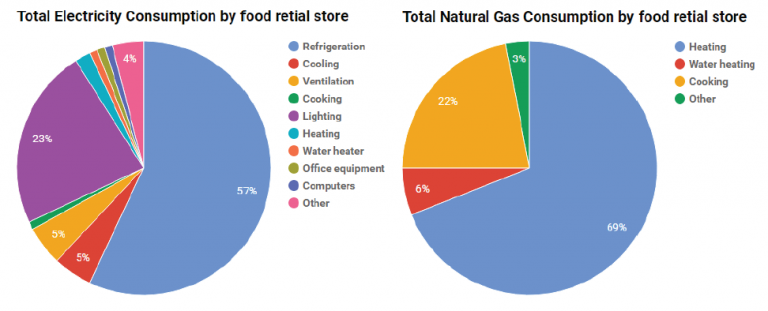The Problem
Food retail stores or supermarkets utilize an average of 52.5 kilowatt hours (kWh) of electricity and 38,000 Btu (British thermal unit for heat) of natural gas per square feet annually. It has been established that a 10% reduction in energy costs for the average supermarket is equivalent to increasing net profit margins by 16%.
In food retail stores, refrigeration and lighting are the bulk end uses for electricity accounting for about 80% of the total use, likewise space heating, and cooking dominates natural gas use. The energy consumption for refrigeration is high due to the fact that most of the food products have to be kept in refrigerators to preserve them and ensure product quality.
After cooling, the seasonality of loads is another factor that increases the use of energy. Seasonal loads can be the result of changes in weather, such as the diverse seasons or operation of the building. For example in the season of summer, elevated usage of electricity for refrigeration is observed in order to sustain the refrigerator temperature compared to the outside heat.

Anomalies and unexplained peaks in consumption or electric demand that go unnoticed can cost the supermarkets money. Regardless of whether the peak is caused by an equipment malfunction or an error in the monthly meter reading, it demands immediate attention. Malfunctioning equipment can damage other components if left unchecked.
Often the limitation of many existing stores is the lack of adequate metering. Submetering of individual energy systems such as lighting, ventilation, computer rooms, etc. must be considered if meaningful energy information is to be made readily available for optimum energy savings.
For all the energy concerns in food retail stores, remote data acquisition is considered as a solution that eliminates most manual data collection and entry.

The Solution
The ultimate aim of energy savings in food retail store or supermarket is to reduce energy bills. To accomplish peculiar energy savings and energy optimization, submetering of individual energy systems such as lighting, ventilation, computer rooms, etc. is optimum. For sub-metering practices, it can be considerably cumbersome for the system maintenance person to measure the energy data of every meter manually. An energy management system plays an indispensable role in this circumstance.
marc.energy can provide metering, submetering and monitoring functions that allow facility managers to gather data that allows them to make more informed decisions about energy use. marc.energy is a cloud and on-premise based next generation energy data analytics platform for demand side management of energy loads and process parameter monitoring.
marc.energy is a very effective solution as it is an energy management system; that focuses on advantageous practices of accurate data acquisition, energy monitoring, and platform independent data analysis.
With marc.energy any electric anomalies and unexplained peaks can be monitored and traced. Consequently, the reason for the peak can be identified whether it is caused by an equipment malfunction or an error in the monthly meter reading. If the equipment malfunctions, immediate attention must be given. If there is an error in the billing statement, communicating with the electricity company should be the first step in identifying the causes of unexplained consumption or demand peaks.

The Benefits
- Accurate energy monitoring and real-time energy consumption
- Better information to make decisions that can help optimize energy performance
- Ability to record actual energy usage (no estimates)
- Ability to identify and eliminate wasted energy
- Submetering is provided to monitor individual systems like lighting, refrigeration, computer rooms, etc.
- Ability to measure and predict the seasonal loads
- Any electric anomalies and unexplained peaks can be monitored, traced and identified
- Benchmarking for different energy systems can be established with comparative ease
- Graphs and reports in the most simplified format so that anyone can easily understand the energy usage






